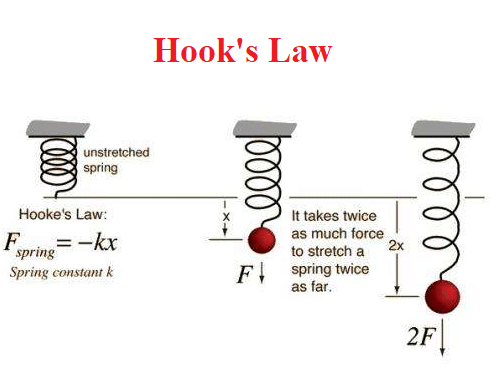Hooke’s Law is a rule in science that says when you stretch or squish something, like a rubber band or a spring, the amount it stretches or squishes is related to how hard you’re pulling or pushing on it. The more you pull or push, the more it stretches or squishes. This rule helps us understand how things move and work in the world around us!
Some examples of Hook’s law are listed below:
- A rubber band: When you stretch a rubber band, it gets longer and thinner. The amount it stretches is related to how hard you’re pulling on it.
- A slinky: When you stretch a slinky out and let it go, it bounces back to its original shape. The amount it stretches and bounces back is related to how hard you stretched it.
- A trampoline: When you jump on a trampoline, the surface stretches and bounces back. The amount it stretches and bounces back is related to how hard you jump on it.
- A spring: When you compress a spring, it gets shorter and thicker. The amount it compresses is related to how hard you’re pushing on it.
- A doorstop: When you push a doorstop against a door, it compresses and resists the force of the door. The amount it compresses and resists is related to how hard you’re pushing against it.
Table of Contents
Hooks Law Definition in Simple Words
In stress-strain terms, Hooke’s Law can be defined as:
“The stress applied to an object is proportional to the strain it produces, as long as the object’s elastic limit is not exceeded.“
In simpler terms, this means that the amount of stress (force per unit area) you apply to an object is directly proportional to the amount of strain (deformation) it undergoes, as long as the object is still able to return to its original shape when the stress is removed. This relationship is described by a constant called the modulus of elasticity, which varies depending on the material of the object.
The mathematical form of Hooke’s Law is:
F = -kx
where:
- F is the force applied to the spring or elastic object
- x is the displacement (change in length or deformation) of the spring or elastic object
- k is the spring constant, which is a measure of the stiffness of the spring or elastic object.
The negative sign in the equation indicates that the force exerted by the spring or elastic object is opposite in direction to the displacement. This means that when you stretch or compress a spring, it exerts a force that tries to return it to its original length or shape.

Simple Case to Explain Hook’s Law
Imagine you have a spring with a spring constant (k) of 5 N/m (newtons per meter). You apply a force of 10 N to the spring and it stretches by 2 meters. How much force would be required to stretch the spring by 3 meters?
Using Hooke’s Law, we can set up the equation:
F = -kx
where:
- F is the force applied to the spring
- k is the spring constant
- x is the displacement of the spring
In this case, we know that F = 10 N and x = 2 m, and we want to find F when x = 3 m.
First, we can use the given values to solve for the spring constant:
k = F/x = 10 N / 2 m = 5 N/m
Now we can use the equation to solve for F when x = 3 m:
F = -kx = -(5 N/m)(3 m) = -15 N
So the force required to stretch the spring by 3 meters would be -15 N, which means that the spring would exert a force of 15 N in the opposite direction (since the negative sign indicates that the force is opposite to the displacement). This example demonstrates how Hooke’s Law can be used to predict the behaviour of a spring when a force is applied to it.
Solved Problems-Hook’s Law
| # | Problem Statement | Formula | Calculation Steps |
| 1 | A spring with a spring constant of 50 N/m is stretched by a force of 10 N. What is the displacement of the spring? | F = kx | x = F/k = 10 N / 50 N/m = 0.2 m |
| 2 | A steel rod of length 2 m and cross-sectional area 0.01 m² is stretched by a force of 5000 N. What is the stress on the rod? | σ = F/A | σ = 5000 N / 0.01 m² = 500 MPa |
| 3 | A rubber band with a spring constant of 2 N/m is stretched by 0.05 m. What is the force applied to the rubber band? | F = kx | F = kx = 2 N/m * 0.05 m = 0.1 N |
More Links
Resilience: Examples from Physics and Everyday Life
What Is Malleability in Metal?
Yield Point| Definition and Stress-Strain Relation
Stress in Physics| Definition and Easy Examples
Elastic Limit| Definition, Formula, and Simple Explanation
The Spring Constant & Spring Force Concept
Joke of the Day
Why did Hooke’s Law break up with Boyle’s Law?
Because Boyle’s Law was too dependent on pressure and Hooke’s Law wanted a more flexible relationship!
- BCl3 Lewis Structure in four simple steps - November 1, 2023
- PH3 Lewis Structure in four simple steps - October 8, 2023
- PF3 Lewis structure in four simple steps - September 24, 2023



